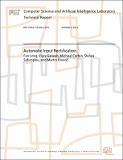Automatic Input Rectification
Author(s)
Long, Fan; Ganesh, Vijay; Carbin, Micheal; Sidiroglou, Stelios; Rinard, Martin
DownloadMIT-CSAIL-TR-2011-044.pdf (16.56Mb)
Other Contributors
Computer Architecture
Advisor
Martin Rinard
Metadata
Show full item recordAbstract
We present a novel technique, automatic input rectification, and a prototype implementation called SOAP. SOAP learns a set of constraints characterizing typical inputs that an application is highly likely to process correctly. When given an atypical input that does not satisfy these constraints, SOAP automatically rectifies the input (i.e., changes the input so that is satisfies the learned constraints). The goal is to automatically convert potentially dangerous inputs into typical inputs that the program is highly likely to process correctly. Our experimental results show that, for a set of benchmark applications (namely, Google Picasa, ImageMagick, VLC, Swfdec, and Dillo), this approach effectively converts malicious inputs (which successfully exploit vulnerabilities in the application) into benign inputs that the application processes correctly. Moreover, a manual code analysis shows that, if an input does satisfy the learned constraints, it is incapable of exploiting these vulnerabilities. We also present the results of a user study designed to evaluate the subjective perceptual quality of outputs from benign but atypical inputs that have been automatically rectified by SOAP to conform to the learned constraints. Specifically, we obtained benign inputs that violate learned constraints, used our input rectifier to obtain rectified inputs, then paid Amazon Mechanical Turk users to provide their subjective qualitative perception of the difference between the outputs from the original and rectified inputs. The results indicate that rectification can often preserve much, and in many cases all, of the desirable data in the original input.
Date issued
2011-10-03Publisher
MIT CSAIL
Series/Report no.
MIT-CSAIL-TR-2011-044